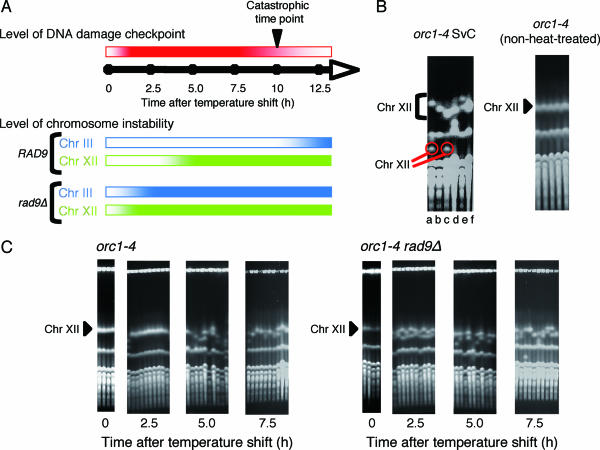FIG. 1.
Extreme instability of chromosome XII in orc1-4 mutant cells grown at the restrictive temperature. (A) Time profiles for the status of DNA damage checkpoint control and the induction of instability in Chr III and Chr XII in orc1-4 cells after the temperature shift. Intensities of colors (red for the DNA damage checkpoint, blue for Chr III instability, and green for Chr XII instability) indicate the strength for each category. The time profiles for the DNA damage checkpoint and the instability of Chr III are based on our previous observations (38), and the time profile for the instability of Chr XII is from data obtained in this study. (B) Size aberration of chromosome XII in orc1-4 diploid cells surviving after incubation at 37°C for 24 h. Six clones of orc1-4 SvC (a to f) were isolated, grown in YPD at 23°C, and subjected to PFGE analysis followed by ethidium bromide staining, all as described in Materials and Methods. As a control experiment, another set of non-heat-treated orc1-4 clones was similarly examined by PFGE analysis. Positions of Chr XII in the gel are indicated by a triangle for the normal size, a bracket for aberrant sizes, and red circles for extensively reduced sizes. (C) Time course for induction of Chr XII instability in orc1-4 and orc1-4 rad9Δ diploid cells after shifting the growth temperature to 37°C. RD603 (orc1-4/orc1-4) and RD613 (orc1-4/orc1-4 rad9Δ/rad9Δ) were grown as described in Materials and Methods. Aliquots were withdrawn at the indicated time points after the temperature shift to 37°C, appropriately diluted with distilled water, spread on YPD plates, and incubated at 23°C for 5 to 7 days. Five or 10 colonies were randomly chosen from cells recovered at each time point, grown in YPD at 23°C, and subjected to PFGE analysis.

